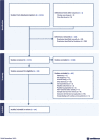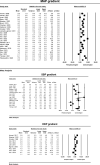Comparison of Central and Peripheral Arterial Blood Pressure Gradients in Critically Ill Patients: A Systematic Review and Meta-Analysis
- PMID: 38787296
- PMCID: PMC11132324
- DOI: 10.1097/CCE.0000000000001096
Comparison of Central and Peripheral Arterial Blood Pressure Gradients in Critically Ill Patients: A Systematic Review and Meta-Analysis
Abstract
Objectives: Measurement of blood pressure taken from different anatomical sites, are often perceived as interchangeable, despite them representing different parts of the systemic circulation. We aimed to perform a systematic review and meta-analysis on blood pressure differences between central and peripheral arterial cannulation in critically ill patients.
Data sources: We searched MEDLINE, Cochrane Central Register of Controlled Trials, and Embase from inception to December 26, 2023, using Medical Subject Headings (MeSH) terms and keywords.
Study selection: Observation study of adult patients in ICUs and operating rooms who underwent simultaneous central (femoral, axillary, or subclavian artery) and peripheral (radial, brachial, or dorsalis pedis artery) arterial catheter placement in ICUs and operating rooms.
Data extraction: We screened and extracted studies independently and in duplicate. We assessed risk of bias using the revised Quality Assessment for Studies of Diagnostic Accuracy tool.
Data synthesis: Twenty-four studies that enrolled 1598 patients in total were included. Central pressures (mean arterial pressure [MAP] and systolic blood pressure [SBP]) were found to be significantly higher than their peripheral counterparts, with mean gradients of 3.5 and 8.0 mm Hg, respectively. However, there was no statistically significant difference in central or peripheral diastolic blood pressure (DBP). Subgroup analysis further highlighted a higher MAP gradient during the on-cardiopulmonary bypass stage of cardiac surgery, reperfusion stage of liver transplant, and in nonsurgical critically ill patients. SBP or DBP gradient did not demonstrate any subgroup specific changes.
Conclusions: SBP and MAP obtained by central arterial cannulation were higher than peripheral arterial cannulation; however, clinical implication of a difference of 8.0 mm Hg in SBP and 3.5 mm Hg in MAP remains unclear. Our current clinical practices preferring peripheral arterial lines need not change.
Copyright © 2024 The Authors. Published by Wolters Kluwer Health, Inc. on behalf of the Society of Critical Care Medicine.
Conflict of interest statement
Dr. Khanna consults for Edwards Lifesciences, Medtronic, Potrero Medical, GE Healthcare, Philips North America, Caretaker Medical, and Retia Medical. He is funded by an National Institutes of Health/National Center for Advancing Translational Sciences KL2 award for assessment of blood pressure and oxygenation in postoperative patients and a Wake Forest Hypertension and Vascular Research award for studying the relationship between serum renin and outcomes in patients with septic shock. Dr. Duggal consults for ALung Technologies and receives funding from National Heart, Lung, and Blood Institute U grant for the Prevention and Early Treatment of Acute Lung Injury (PETAL) network to study prevention and treatment of acute lung injury. The remaining authors have disclosed that they do not have any potential conflicts of interest.
Figures
Similar articles
-
Peripheral arterial blood pressure monitoring adequately tracks central arterial blood pressure in critically ill patients: an observational study.Crit Care. 2006;10(2):R43. doi: 10.1186/cc4852. Crit Care. 2006. PMID: 16542489 Free PMC article.
-
Femoral-radial arterial pressure gradients in critically ill patients.Crit Care Resusc. 2009 Mar;11(1):34-8. Crit Care Resusc. 2009. PMID: 19281442
-
Central Versus Peripheral Invasive Arterial Blood Pressure Monitoring in Liver Transplant Surgery.Cureus. 2022 Dec 29;14(12):e33095. doi: 10.7759/cureus.33095. eCollection 2022 Dec. Cureus. 2022. PMID: 36721557 Free PMC article.
-
Mean Arterial Pressure Targets and Patient-Important Outcomes in Critically Ill Adults: A Systematic Review and Meta-Analysis of Randomized Trials.Crit Care Med. 2023 Feb 1;51(2):241-253. doi: 10.1097/CCM.0000000000005726. Epub 2022 Nov 18. Crit Care Med. 2023. PMID: 36661452
-
Blood pressure targets in adults with hypertension.Cochrane Database Syst Rev. 2020 Dec 17;12(12):CD004349. doi: 10.1002/14651858.CD004349.pub3. Cochrane Database Syst Rev. 2020. PMID: 33332584 Free PMC article.
Cited by
-
Decoding Hypotension: Porcelain Aorta and Its Unexpected Normalcy.Cureus. 2025 Feb 3;17(2):e78417. doi: 10.7759/cureus.78417. eCollection 2025 Feb. Cureus. 2025. PMID: 40046380 Free PMC article.
References
-
- Frezza EE, Mezghebe H: Indications and complications of arterial catheter use in surgical or medical intensive care units: Analysis of 4932 patients. Am Surg 1998; 64:127–131 - PubMed
-
- Baptistella C, Mendes CA, Silva MJ, et al. : Retrospective observational single-center study of complications of arterial indwelling catheters for invasive blood pressure in intensive care unit patients. Angiology 2022; 73:431–437 - PubMed
-
- Garland A, Connors AF, Jr: Indwelling arterial catheters in the intensive care unit: Necessary and beneficial, or a harmful crutch? Am J Respir Crit Care Med 2010; 182:133–134 - PubMed
Publication types
MeSH terms
LinkOut - more resources
Full Text Sources




